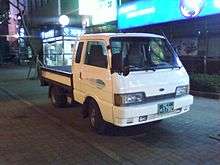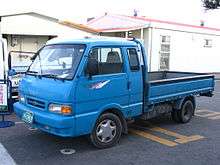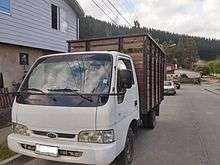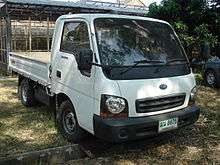Kia Bongo
| Kia Bongo | |
|---|---|
_2-door_cab_chassis_(2015-06-18).jpg) | |
| Overview | |
| Manufacturer | Kia Motors |
| Also called |
Kia Frontier Forland K1 |
| Production | 1980–present |
| Assembly |
Gwangju, South Korea (Gwangju Plant) Indonesia Quito, Ecuador (AYMESA) Montevideo, Uruguay (Nordex) |
The Kia Bongo (Hangul:기아 봉고), also known as the Kia K-Series or Kia Besta, is a pick-up truck and van produced by the South Korean manufacturer Kia Motors since 1980.
The Bongo was first launched in 1980 under the name Bongo. In 1997, the third generation Bongo Frontier was launched. As of 2004, the Kia Bongo was in its fourth version, confusingly sold as the Kia Bongo III. "Frontier" was dropped from the name with this revision.
Background
Kia has produced small and large trucks for the Korean market for at least 25 years. Rear-wheel-drive Bongo trucks have been on the market in Korea since at least the late 1980s, and these were equipped with a four-cylinder diesel engine. The Kia Bongo Frontier was originally available in RV or pickup trucks. It was replaced by the Kia Bongo III in 2004. The Bongo Frontier was the first Kia Motors car to be exported to Europe and South America.
First generation (1980–1993)

Production started in 1980 and coachvan started in 1981. Early Bongos had round headlights, although these were changed for square units in 1981. The first Bongos also used "Kiamaster" logos rather than simply "Kia". The Bongo originally came with the 2.2 liter "S2" engine with 70 PS (51 kW), although the 1.4 liter "UC" petrol engine was added in 1985. 'Wide Bongo' production started in 1987. Between 1987 and 1989 the Bongo was sold as the "Power Bongo", to reflect an upgrade to the 80 PS (59 kW) 2.4 litre "SF" diesel engine. The Power Bongo also has wide rectangular headlights, rather than the smaller units used previously. The first generation Bongo was removed from production in December 1993, although the tougher Ceres version continued for another six years.
.jpg)
Kia Ceres
The Kia Ceres was a special agricultural version, a one-ton truck. It shared a slightly longer front end with the Kia Titan. From 1986 this was also available with four-wheel drive; eventually the rear-wheel drive models were cancelled in the domestic market. The Ceres model was sold instead of the Bongo in some export markets where conditions are tough, such as the Philippines, Latin America, Australia and Turkey. The Ceres utilized the original BA2 cabin but with a unique front clip. It was facelifted in 1995 when it received a new front clip with round headlights.
Second generation (1989–1997)


In January 1989 the second generation Bongo Wide (sold as plain "Bongo" in most export markets) appeared. It was largely a rebadged SR-series Mazda Bongo Brawny. In 1992, a 2.7-litre engine was introduced. In October 1994, Kia's new logo replaced the old "chimney" design. In 1995 a reengined and lightly facelifted version called the "Bongo J2" appeared; this reflected the name of the new engine. The second generation Bongo model for passengers (coach) is named the Kia "BestA", usually referred to as 'Besta' - a word that unfortunately means "beast" (or "stupid") in Brazil. This did not stop the Besta from immediately becoming the highest selling minivan in the Brazilian market.[1] The Besta name was also used for cargo van versions in many countries. The Besta originally had the 2.2 liter diesel engine with 62 PS (46 kW), but at the end of 1994 the 80 PS (59 kW) 2.7 liter J2 unit was placed in the Besta as well. This version can reach 128 km/h (80 mph).[1]

The Bongo J2 also formed the basis for the new Kia Pregio, which replaced the Kia Besta (the coach version of the Bongo). The Besta 2.7 did continue in production alongside the Pregio until at least the summer of 1997[1] for markets where this lower priced model retained some popularity. Export models of the second generation Bongo often used the K2400 or K2700 labels.
Third generation (1997–2004)

The third generation Bongo appeared in April 1997, now with the "Bongo Frontier" name. The related van version, Pregio, was introduced in November 1995 and continued in production until 2006. A four-wheel drive version ("Bongo Frontier All Terrain") appeared in December 1999, this meant the final end of the Ceres trucks (with origins dating back to the 1977 Mazda Bongo BA2). The third Bongo had the same JS series 2.7 litre engine with 80 PS (59 kW) as used in the previous model, although an optional 3 litre JT engine with 90 PS (66 kW) was also made available from the beginning. In August 2001 this engine received an additional four horsepower.

Facelift
A facelifted Bongo was introduced in 2000. The truck was discontinued in late 2003, while the Van and Coach models continued to be built until May 2005. With stricter emissions controls, the 4x4 dump truck model was discontinued at the same time.
Fourth generation (2005–present)
The fourth generation became known as the Kia Bongo III and the model was facelifted again. Engines were modernized (now with a common rail option) and gradually became more environmentally friendly.
Due to tighter emissions rules 1.2-ton and 1.4-ton discontinued in November 2006, and then because of low marketing, Coachvan, van, and trucks except 1-ton and 1.3-ton all ceased production in December 31, 2007. The Bongo III went on hiatus between October 2011 and January 2012, due to tighter emissions rules, but reemerged with a Euro V compliant engine.
The Bongo III was exclusively available in the Philippines as the K2700 variant, since 2006.
A coachvan version of the Bongo III is still in production in Indonesia, where it is sold as the Kia Travello.
European sales of Kia K-Series (with the exception of Russia and Turkey) has been discontinued in late 2007.
Facelift
Kia Bongo was updated 2014, with new gearbox 6-speed engine and much more efficient Euro IV standards, new body design that includes different front and added grille, and new tires ring size 15. The K2500, K2700 and K3000S have either a 2.5 litre turbocharged engine that delivers 130 hp, or an optional 2.7 litre engine that pushes out just 80 hp and another 3.0 liter that adds five more horsepower from the 2.7 litre. It provides all the sufficient loading capabilities, also they have three cab options: standard, super and double cabin. There is another model that is called the K400S and K4000G, which is the bigger van version of the K2500, the K2700 and the K3000II.
Names
In some markets, including Europe, Australia and South America, the Bongo is branded as the Kia K-Series as: K2400 / K2700, but also as "Kia Frontier".
Right hand drive models are produced in Indonesia (locally marketed as Big-Up), while left hand drive models were produced in Ecuador from 2001 to 2004.[2]
In Taiwan, the Bongo is known as Kia Kaon.[3]
See also
References
| Wikimedia Commons has media related to Kia Bongo. |
- 1 2 3 "Saiba mais, tudo sobre a Kia Besta de 1993 a 2005." [Know more: Everything about the 1993-2005 Kia Besta]. Encontracarros.com (in Portuguese). 2013-01-09. Retrieved 2013-03-14.
- ↑ Mazur, Eligiusz, ed. (2006). World of Cars 2006·2007. Warsaw, Poland: Media Connection Sp. z o.o. p. 252. ISSN 1734-2945.
- ↑ "Kia Motors Taiwan". Retrieved 7 June 2013.
| Kia Motors, a division of Hyundai Motor Group, automobile timeline, 1970s–present | ||||||||||||||||||||||||||||||||||||||||||||||||
|---|---|---|---|---|---|---|---|---|---|---|---|---|---|---|---|---|---|---|---|---|---|---|---|---|---|---|---|---|---|---|---|---|---|---|---|---|---|---|---|---|---|---|---|---|---|---|---|---|
| Type | 1970s | 1980s | 1990s | 2000s | 2010s | |||||||||||||||||||||||||||||||||||||||||||
| 0 | 1 | 2 | 3 | 4 | 5 | 6 | 7 | 8 | 9 | 0 | 1 | 2 | 3 | 4 | 5 | 6 | 7 | 8 | 9 | 0 | 1 | 2 | 3 | 4 | 5 | 6 | 7 | 8 | 9 | 0 | 1 | 2 | 3 | 4 | 5 | 6 | 7 | 8 | 9 | 0 | 1 | 2 | 3 | 4 | 5 | 6 | 7 | |
| City car | Visto | Picanto | Picanto | |||||||||||||||||||||||||||||||||||||||||||||
| Ray | ||||||||||||||||||||||||||||||||||||||||||||||||
| Subcompact car | Brisa | Pride | Qianlima | |||||||||||||||||||||||||||||||||||||||||||||
| Brisa II / K303 | Avella | Rio | Rio | Rio | ||||||||||||||||||||||||||||||||||||||||||||
| Compact car | 124 | Capital | cee'd | cee'd | ||||||||||||||||||||||||||||||||||||||||||||
| Sephia | Sephia | Cerato | Forte | Forte | ||||||||||||||||||||||||||||||||||||||||||||
| Mid-size car | Concord | Credos | Optima | Optima | Optima | Optima | ||||||||||||||||||||||||||||||||||||||||||
| Full-size car | 132 | Enterprise | Opirus | Cadenza | Cadenza | |||||||||||||||||||||||||||||||||||||||||||
| 604 | Potentia | Quoris | ||||||||||||||||||||||||||||||||||||||||||||||
| Sports car | Elan | |||||||||||||||||||||||||||||||||||||||||||||||
| Compact SUV | Sportage | Sportage | Sportage | Sportage | ||||||||||||||||||||||||||||||||||||||||||||
| Retona | ||||||||||||||||||||||||||||||||||||||||||||||||
| Mid-size SUV | Sorento | Sorento | Sorento | |||||||||||||||||||||||||||||||||||||||||||||
| Mohave | ||||||||||||||||||||||||||||||||||||||||||||||||
| Mini MPV | Venga | |||||||||||||||||||||||||||||||||||||||||||||||
| Compact MPV | Joice | Soul | Soul | |||||||||||||||||||||||||||||||||||||||||||||
| Carens | Carens | Carens | Carens | |||||||||||||||||||||||||||||||||||||||||||||
| Large MPV | Carnival | Carnival | Carnival | |||||||||||||||||||||||||||||||||||||||||||||
| Pickup truck | Bongo | Wide Bongo | Bongo Frontier | Bongo | ||||||||||||||||||||||||||||||||||||||||||||
| Minivan | Besta | Pregio | ||||||||||||||||||||||||||||||||||||||||||||||
| Bus | Combi | |||||||||||||||||||||||||||||||||||||||||||||||
| Granbird | Granbird | |||||||||||||||||||||||||||||||||||||||||||||||
